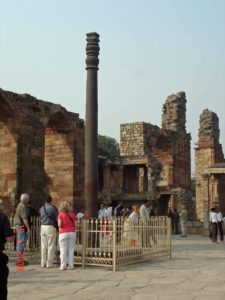
Iron Pillar
Qutub Minar complex is a fascinating array of tombs, monuments and buildings in the Mehrauli district of New Delhi. History in this complex you could say dates back to an Iron Pillar constructed in the 4th century. The Iron Pillar removed from Udayagiri caves near the city of Vidisha in Madhya pradesh and erected in its current place in New Delhi in 1233 CE by Sultan Qutbuddin Aibak.
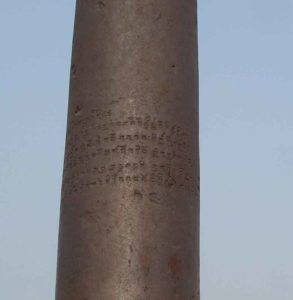
4th Century Brahmi script
The Iron Pillar is seven metres in height and weighs over 6,000 kg. The composition of metals used in its construction considered a remarkable feat of workmanship attributed to the skill and knowledge of ancient Indian metallurgy. This is because of the Iron Pillar’s amazing survival over the centuries against rust and corrosion. The Iron Pillar has a Brahmic inscription that predates the Islamic Minar by centuries.
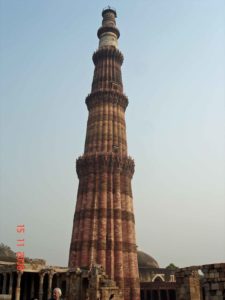
Qutub Minar
Qutub Minar (Victory Tower)
The Qutub Minar is a five-story Victory Tower commissioned by Qutbuddin Aibak in 1200 AD, and completed by his successor and son-in-law Iltutmish. Qutbuddin Aibak a former slave general,became the first Sultan of Delhi and ruled from (1206-1210). Qutbuddin Aibak built the Qutub Minar and the Quwwat-ul-Islam Mosque to mark the foundation of the Delhi Sultanate. Islamic rule lasted over three hundred years from 1206-1555.
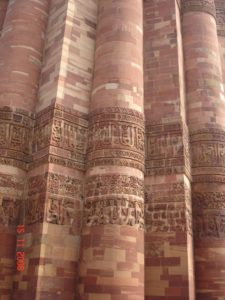
Bands of intricate calligraphy
Made from colored sandstone and decorated with bands of intricate inscriptions and verses from the Koran, the workmanship still crisp and clear after all these centuries, the calligraphy subtlety highlighted with iron oxide and designed to stand out against the sandstone bricks. The Qutub Minar comprises several superimposed flanged and cylindrical shafts, separated by four balconies supported by decorative brackets known as muqarnas corbels. The brackets bare closer inspection, they adorn the elegant tower like an exquisite elaborately designed lace ruff (worn by European women in the Elizabethan era). The first three storeys of the Qutub Minar made of red sandstone, the fourth, fifth and sixth storeys are a contrast in white marble and sandstone. The Qutab Minar is a stunning piece of architecture, and at 238 ft in height towers majestically over the entire complex. It is the tallest brick minaret in the world.
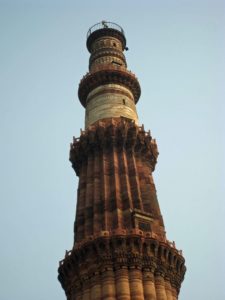
Balconies supported by muqarnas corbels.
Sadly you are not allowed to view the interior of the Qutub Minar any more due to a terrible tragedy in 1981. Access inside the tower is through a narrow circular staircase with 379 steps to the top. This day there were 300-400 people, including children on a school excursion, in the tower when a power failure occurred throwing the interior into total blackness. Panic and a stampede ensued resulting in the death of 45 people, including many children. Following this tragedy, the public no longer has access to the interior of the tower.
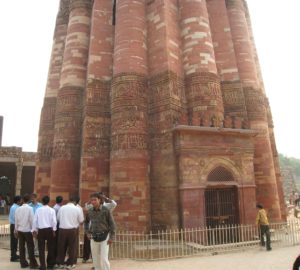
Entrance Qutub Minar
Apart from the Iron Pillar of Delhi, other historical monuments and tombs within the Qutub Minar complex are – Quwwat-ul-Islam Mosque, Alai Darwaza, the Tomb of Iltutmish, the Alai Minar, Ala-ud-din’s Madrasa and Tomb, and the Tomb of Imam Zamin.
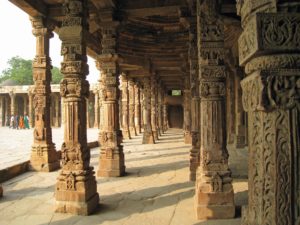
Quwwat-ul-Islam Mosque
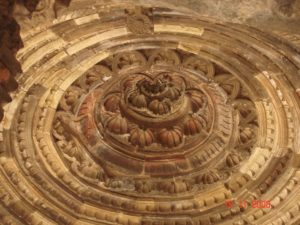
Ceiling dome
Quwwat-ul-Islam Mosque
In 1193 CE Sultan Qutb-ud-din-Aibak started construction of the Quwwat-ul-Islam Mosque to mark his victory over Rajputs. Many of the remaining pillared cloisters of the Mosque are decorated with distinct Hindu motifs such as bells and garlands. When the Sultans invaded the land they demolished twenty-seven Hindu and Jain Temples and the Mosque was built from materials plundered from these temples. Confirmation of this can be seen on a Persian inscription on the inner eastern gateway of the Mosque. Under a dome in one of the pillared cloisters is a beautifully crafted ceiling decoration, it is quite outstanding and probably came from a demolished Hindu or Jain temple.
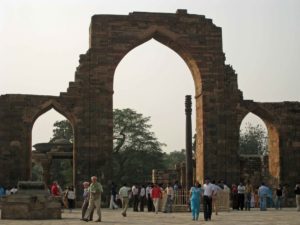
Ruins Quwwat-ul-Islam Mosque – Arched Screens
Tomb of Iltutmish
Iltutmish, son in-law of Sultan Qutbuddin Aibak, and the second Sultan of Delhi reigned from 1211 -1236 AD. The exterior walls of his tomb are fairly ordinary, and roof domes have collapsed, however the entrance door is decorated in exquisite script. The interior walls of Iltutmis’ tomb are richly decorated with intricate designs and calligraphy, quite beautiful in effect.
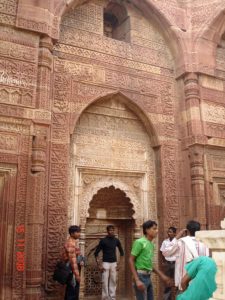
Prayer Niche in white marble
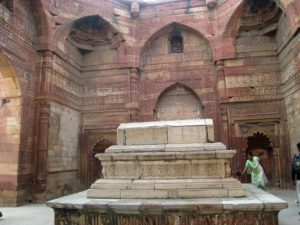
The west wall of the tomb has three mihrab’s or prayer niche’s, the center prayer niche exquisitely decorated in white marble. The main cenotaph in white marble sits on a raised platform in the center of the chamber. The chamber is about 9 m.square.
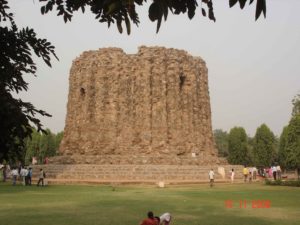
Incomplete Alai Minar (Tower)
Alai Minar
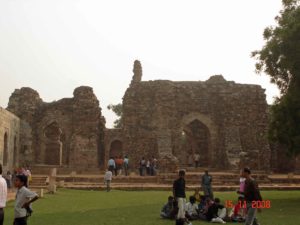
Tomb of Ala-ud-din Khilji
Related Posts:
- Sights and Sounds – New Delhi|India
- Incredible India|Delhi City
- Terracotta Army| Emperor
- Snapshot of Cambodia Kampuchea
- China a most attractive destination|Top ten places to visit in China
- Flight of the Giraffes Duba Plains
- Magnetic Island a suburb of Tropical Townsville
- Sensoji-Asakusa Kannon Temple Tokyo Japan
- Romantic Road-Attractions Germany
- Skydeck 88 Experience-a great place to visit in Melbourne
- Jewels of Venice
Speak Your Mind